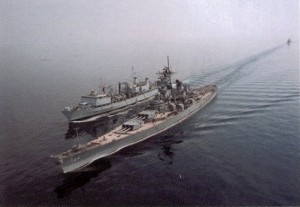According to the Globe and Mail, Canada’s government worries that the HMCS Protecteur and the HMCS Preserver, their two 40-year-old single-hull oilers, are going to pose an environmental anti-access threat to Canadian Forces:
“These vessels are single-hulled, which violates most international environmental standards,” states a February, 2010 briefing note provided to Treasury Board president Stockwell Day by his senior public servant, Michelle d’Auray.
Mr. Day, who is responsible for finding savings to tackle the federal deficit, had requested a briefing on planned spending by the navy.
The note, which indicates it is based on discussions with National Defence officials, warns exemptions for single-hulled vessels are about to expire.
“These vessels have been grandfathered for most European ports until later this year and in the U.S. until 2015. Should the [vessels] be unable to enter European ports after this year, their use may be restricted to continental operations and would impact the Navy’s ability to sustain a Task Group,” it states. The note was released to The Globe in response to a request under the Access to Information Act.
Well, aside from the fact that naval auxiliaries are exempt from the MARPOL standards, all countries are obligated to work towards compliance. But, before we get all complacent and chortle about the loopholes inherent in international treaties, just remember that countries certainly have the right to quietly indicate that single-hulled tankers are unwelcome. It is a perfect way for nations to suddenly toss America’s at-sea replenishment plans into disarray.
And that, in itself could lead to a considerable anti-access challenge–one that potentially is far more serious (and immediate) than all those frighteningly nasty DF-21D anti-ship ballistic missiles in China.
But Canada has little to worry about. They have a plan, and they’ve only got to build build 2-3 new ships. The U.S., in comparison, has no plan–Just sort of a fragile hope that some T-AO(X) replacements start getting built, oh, you know, in 2020. The SSBN(X) may yet doom the U.S. to the unhappy prospect of operating a clutch of fifty-year old tankers and replenishment vessels.
In the U.S., all but three of America’s entire stock of oilers are single hull ships. By 2020, pretty much everybody else will be safely operating double-hull craft, and well, regardless of the Navy’s opinions about environmental stewardship, it just won’t be a good place for the U.S. to be strategically. It’s just not wise. No un-threatened ally thinks highly of a hard-run 30-40-year old single hulled oiler loitering about their shores anyway.
Interestingly enough, I’ve been quietly working this issue in various places since January 2010, and, over the coming months, you’ll all be hearing a lot more about the T-AO(X).


{ 6 comments… read them below or add one }
Glad to hear that your work of the last six months was able to influence a major defense program. T-(AO)X sure was floundering for the years prior…
Hey Galrahn! Welcome back to the blogosphere! Shoot a note over them there internets when you get the chance.
And Tom–As you evaluate your options, I gotta say that sometimes the opportunities in the Navy are greater than just the sum of the ships in the fleet. If you go in, by the time you are senior enough to really contribute–to really make a difference–Canada will be confronting an awfully interesting strategic situation. And from that comes a chance at greatness.
Don’t take my word for it. Look at history. Heck, Fleet Admiral Nimitz got his start when the U.S. Navy was a tiny shell of an afterthought. And then he went to Berkeley to establish the first Naval ROTC. The students were just like your peers. The professors too…But Nimitz won the respect of his peers in academia and made the NROTC into an oversubscribed success story–that continues to this very day. And then he made the Navy into a success story…but I think you already know that bit of the Nimitz legend.
I am also very interested in any news related to the T-AO(X).
Congrats on the defensetech gig Craig.
NASSCO could really use the work, and T-AO(X) is right in their wheelhouse. Come on, Navy, get the lead out.
There’s a way to get SSBN(X) without gutting the Navy’s budget, but USAF won’t like it.
Tom, stand firm… your country needs you especially in light of so many others showing indifference. Be proud to serve!
I have to disagree with this sentence:
“But Canada has little to worry about. They have a plan, and they’ve only got to build build 2-3 new ships.”
And that plan has existed for 5-6 years and has yet to get anywhere near a finalized design or signed contracts.
http://www.thestar.com/news/canada/article/835702–navy-to-buy-two-new-support-ships-for-2-6-billion
Canada is still two years away from a completed design, and perhaps even further away from the start of construction, especially since the government is apparently unwilling to consider constructing the ships outside of Canada.
The government announced ambitious plans for a national shipbuilding strategy to build 28 ships and 116 smaller vessels over the next 30 years (including the new support vessels), all built in Canadian shipyards, but do not count on this ever actually happening. Canadian governments, and the Canadian public in general, have been historically apathetic when it comes to the military, and there is no sign that is going to change anytime soon.
That knowledge is especially depressing for me, due to my desire to join the Canadian Forces as a naval officer after I graduate, but I have been increasingly finding it difficult to justify joining knowing that I would be serving a country that seems to view the military as a nuisance in the federal budget. A view that is especially prevalent among my fellow students and, thus, the future leaders of Canada.